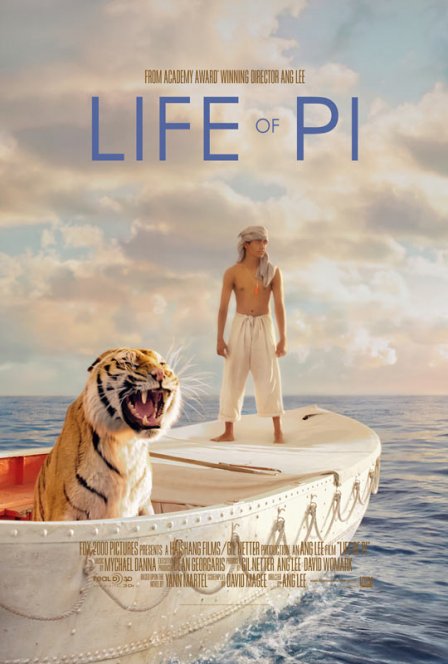There are some books I know I’ll never read, and Life of Pi is one of them. My dad effusively recommended Yann Martel’s novel on so many occasions, I vowed I’d avoid the book out of spite. After a decade since its initial publication, chameleon-like director Ang Lee adapts the unlikely adventure for the big screen. Working from a script by David Magee, Lee overcomes storytelling challenges through sheer spectacle. Life of Pi is one of the better uses of 3D, if not the best, and many sequences are psychedelic marvels.
As a middle aged man, Pi (Irrfan Khan) lives a quiet life in Canada. One day he gets a visit from a young Writer (Rafe Spall), one who has been promised he’ll believe in God after hearing Pi’s story. Through that framing device, the plurality of the movie is in flashback. We see how a younger Pi (Suraj Sharma) left India for Canada by ship along with his family and the animals that make up their zoo. After a dangerous storm, Pi is the only human survivor. Nearly mad with grief, he swims for a lifeboat, where he finds a wild dog, an orangutan, and a Bengal tiger named Richard Parker. Pi struggles to keep the animals alive even as Richard Parker keeps attacking him. But without a hope of rescue, Pi and his companions grow increasingly weary and desperate.
Lee’s masterstroke is how he slowly jettisons realistic imagery after the shipwreck. There are moments where the plane between the sky and the water is invisible, so it looks as if the ship ethereally floats through the air. The 3D enhances the illusion: the beauty of Pi’s surroundings are heartbreaking since his station is so dire. Other effects are more conventional, yet Lee and cinematographer Claudio Miranda handle them with careful detail. When an impossibly large iridescent fish throttles the lifeboat, the frame pops with moody color. Obviously, Richard Parker claws at the camera on more than one occasion. No matter what the illusion, Lee pushes Life of Pi to the limits of 3D so we can understand Pi’s ordeal more viscerally. Making his debut, Sharma has all storytelling weight on his shoulders. Though the Writer expects a God-affirming story, Sharma shrewdly downplays the role, instead focusing on a series of life-preserving tasks. Come to think of it, this has strong similarities to Cast Away, except Pi’s companion is far more deadly than a volley ball.
It’s a foregone conclusion that Pi survives his journey and eventually returns to civilization. I won’t spoil the details here, except to say it should not be enough to convert the Writer into a believer. It’s a screenwriting challenge: adaptation has a way of literalizing the source text, no matter how allegorical and mysterious the author originally intended (Lee ends with a shaggy dog monologue that loses its power when spoken). So instead of a shrewd affirmation of faith, Life of Pi is a reminder of why we need hyperbolic stories, no matter how unlikely.

